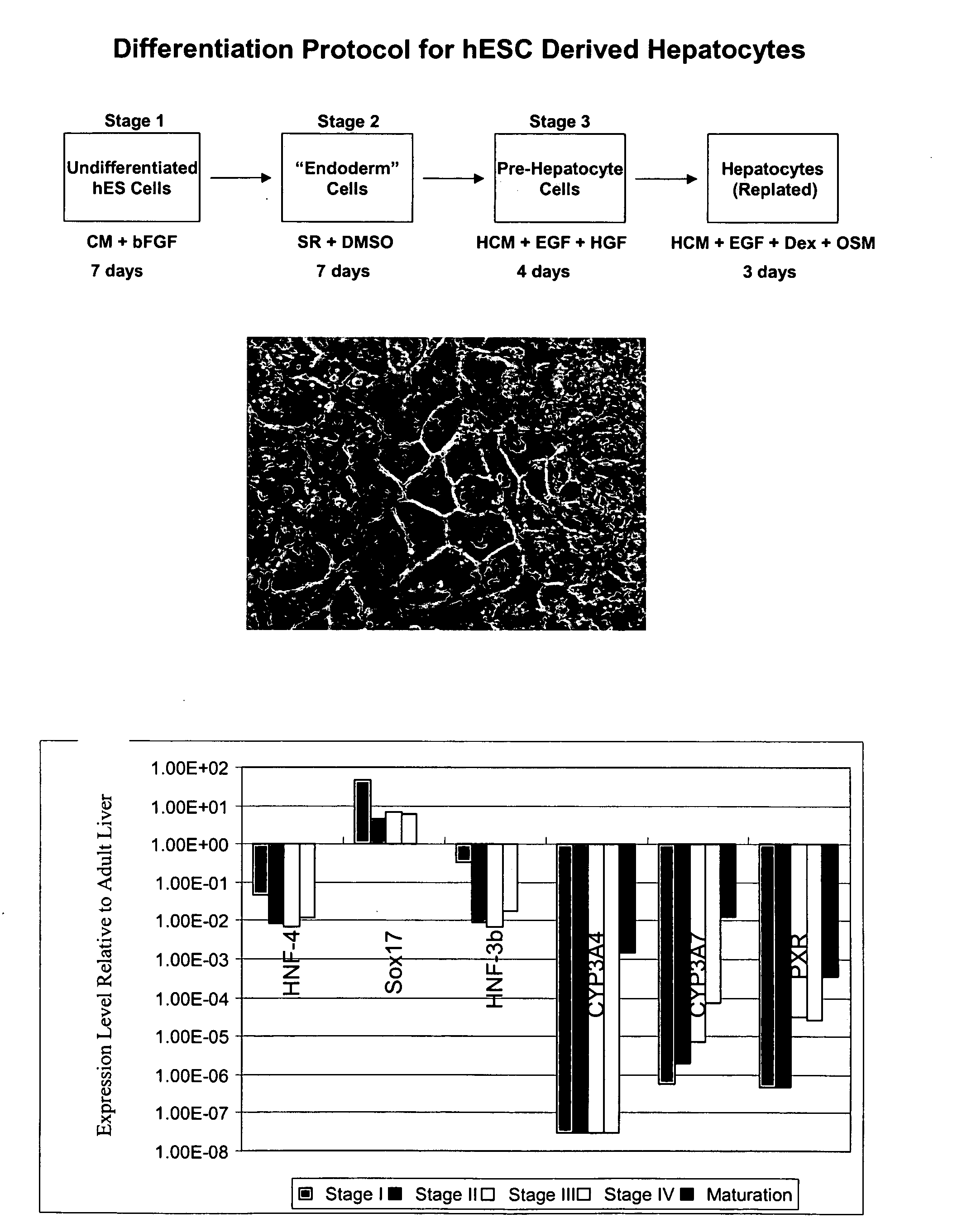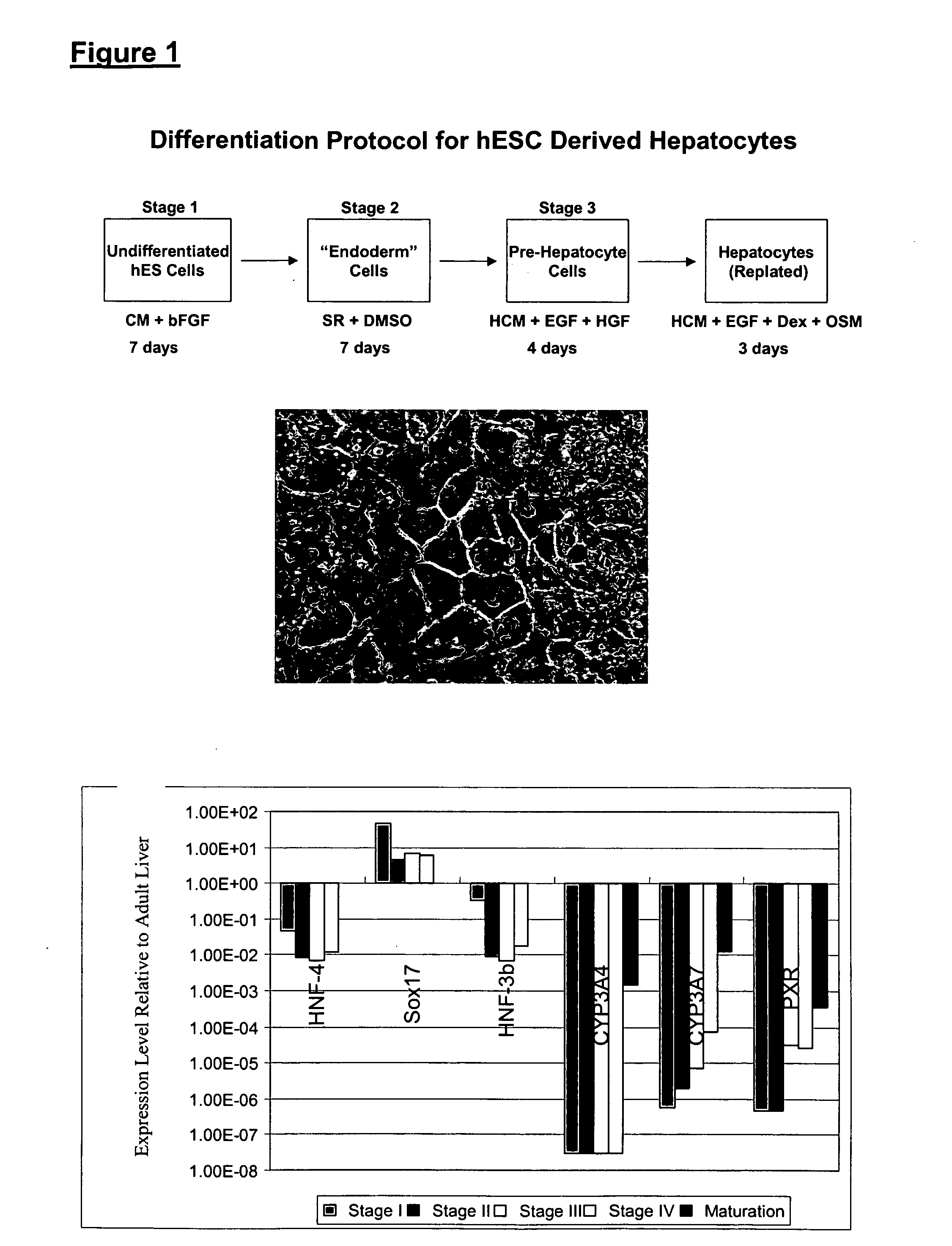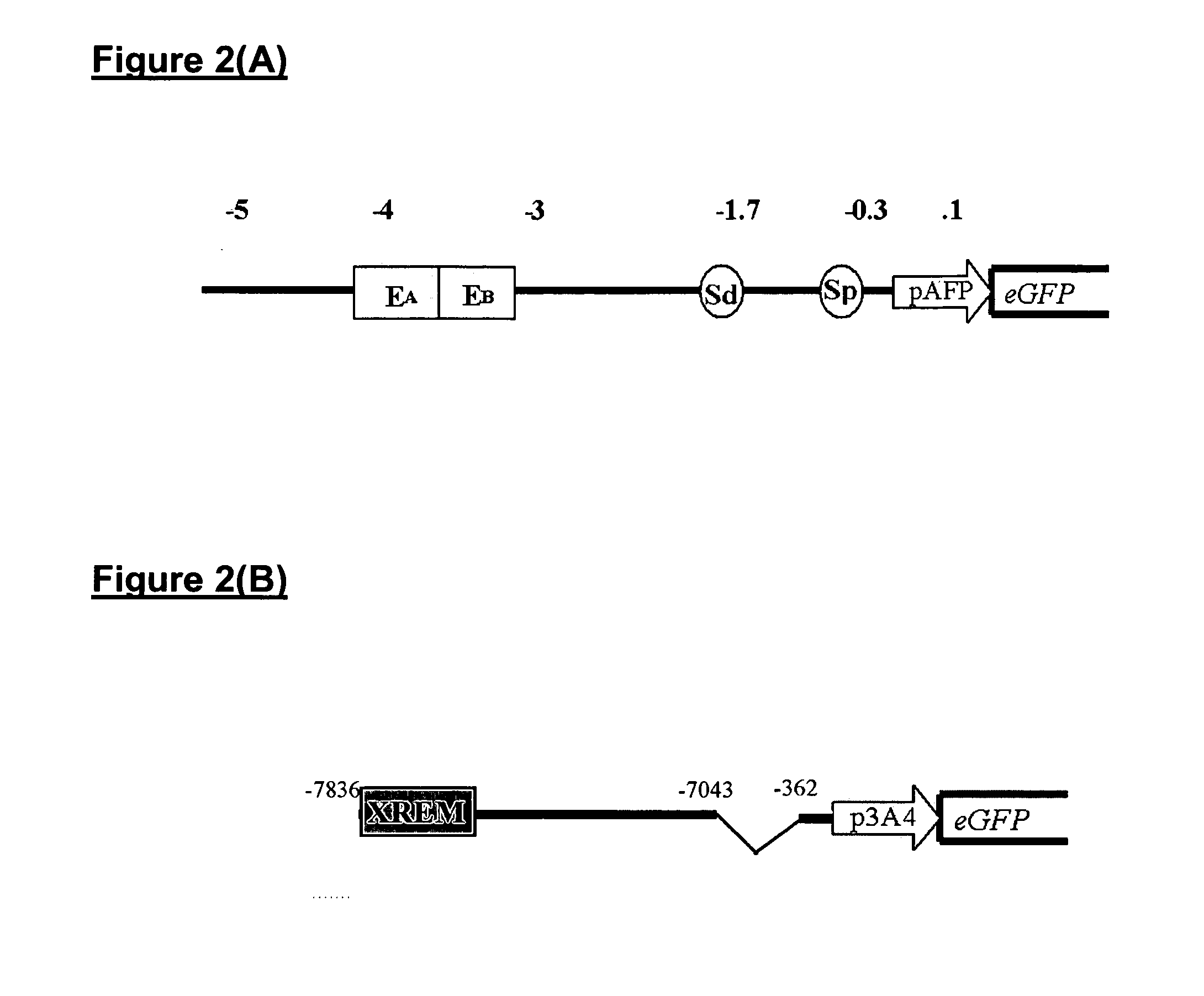Promoter-reporter cells for determining drug metabolism, drug interactions, and the effects of allotype variation
a reporter cell and drug metabolism technology, applied in the direction of genetically modified cells, drug compositions, biocide, etc., can solve the problems of inability to predict humans, low throughput, and inability to meet human needs, so as to minimize the immune response, facilitate excretion, and minimize the effect of kidney damag
- Summary
- Abstract
- Description
- Claims
- Application Information
AI Technical Summary
Benefits of technology
Problems solved by technology
Method used
Image
Examples
example 1
DMSO Protocol for Differentiating hES Cells
[0126]hES cells can be differentiated into hepatocytes according to the scheme shown in FIG. 1.
[0127]In one illustrative experiment, the human ES cells were plated at 1×106 cells per 10 cm well, and grown in mEF conditioned medium containing 8 ng / mL added bFGF for 5 days, changing medium every day. Stage II / III was conducted by culturing the cells in KO-DMEM containing 20% Serum Replacement (Gibco # 10828-028), 2 mM L-glutamine, non-essential amino acids (NEAA), 0.1 mM β-mercaptoethanol, plus 1% DMSO. The medium was changed every day for 7 days.
[0128]Stage IV was then started by changing the medium to HCM containing 10 ng / mL EGF plus 2.5 ng / mL HGF. The medium was changed every day for 4 days.
[0129]The cells were then replated using trypsin or collagenase without scraping. Collagenase passaging was effected by removing supernatant, and adding 1 mL per well of 1 mg / mL Collagenase IV in KO-DMEM pre-warmed to 37° C. After a 5 min incubation, th...
example 2
Generation of hESC Reporter Lines
[0132]The lab work for this example and in Examples 3, 4, and 6 was conducted by Wei Cui, Debiao Zhao, David Hay, and Arlene Ross, at the Dept. of Gene Function & Development, Roslin Institute, Midlothian Scotland, for which the owners of the claimed invention wish to express their gratitude.
[0133]As a model for the reporter hepatocytes of this invention, the human α-fetoprotein and albumin promoters were amplified from human genomic DNA (Promega G3041) with specific primers listed in Table 2.
TABLE 3Primers for Amplifying Hepatocyte Specific PromotersDNA fragmentPrimer sequences (5′-3′)DNA sizeAccession No.α-fetoproteinForward: (SEQ. ID NO:1)5.4 kbNT006216TTGTCGACTTGGGGACTATCTGATCTGGGGReverse: (SEQ. ID NO:2)(330690-336082)TTGGATCCGCCACCCACTTCATGGTTGCTAGalbuminForward: (SEQ. ID NO:3)7.1 kbNT006216GACCCTGTTTTGACTAGTGGCTAGReverse: (SEQ. ID NO:4)(2769969-2777069)TAGGATCCATGGTTACCCACTTCATTGTGCC
[0134]The lentiviral vector used for transfection of the hESCs...
example 3
Differentiation into Hepatocytes and Expression of Reporter Genes
[0143]Undifferentiated hESCs containing the reporter construct were cultured in mEF-CM containing 8 ng / mL bFGF until approximately 70% confluent. The CM was then replaced with SR / DMSO media (Knockout-DMEM containing 20% Serum Replacement, 2 mM I-Glutamine, 1×non-essential amino acids, 0.1 mM β-mercaptoethanol and 1% DMSO) and changed daily for 7 days. The cells were then matured using hepatocyte culture medium (HCM from Cambrex) supplemented with hepatocyte growth factor (HGF) 2.5 ng / mL and EGF 10 ng / mL for another 2 weeks. HCM was changed daily for the first 4 days and every second for the last 10 days. Cells were immunostained after fixation with 100% methanol.
[0144]FIG. 3 shows the results. After DMSO treatment, cells exhibited endoderm-like morphology and following further culture in HCM (supplemented with HGF and EGF), hepatocyte lineage cells (HLCs) formed as foci that were polygonal in shape (FIG. 3A). This morp...
PUM
| Property | Measurement | Unit |
|---|---|---|
| concentrations | aaaaa | aaaaa |
| oxidative stress | aaaaa | aaaaa |
| fluorescent | aaaaa | aaaaa |
Abstract
Description
Claims
Application Information
 Login to View More
Login to View More - R&D
- Intellectual Property
- Life Sciences
- Materials
- Tech Scout
- Unparalleled Data Quality
- Higher Quality Content
- 60% Fewer Hallucinations
Browse by: Latest US Patents, China's latest patents, Technical Efficacy Thesaurus, Application Domain, Technology Topic, Popular Technical Reports.
© 2025 PatSnap. All rights reserved.Legal|Privacy policy|Modern Slavery Act Transparency Statement|Sitemap|About US| Contact US: help@patsnap.com



